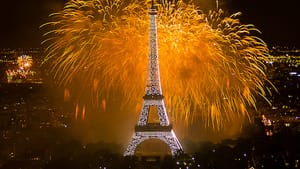Stay in the Loop
BSR publishes on a weekly schedule, with an email newsletter every Wednesday and Thursday morning. There’s no paywall, and subscribing is always free.
Ou sont les Parisiens?
Week One of the Philadelphia Orchestra's Paris Festival

Two years ago, Yannick Nézet-Séguin presented a festival of concerts devoted to the city of St. Petersburg, Russia. Last winter he saluted Vienna, Austria. Now he has turned to Paris, France.
It should be his most expressive and personal festival, because the conductor is French-Canadian and both of his parents grew up in France.
In each of these tributes, Nézet-Séguin has explored the city’s overall culture, not merely its compositions. In the current three-week exploration, that presents a challenge. How to encompass the vastness of Parisian culture in such a limited space? As in the past, the conductor’s choices give a cross-section of personages and invite deeper consideration of their times.
How to choose?
A major distinction is that Vienna and St. Petersburg had constant forms of government from the 11th to the early 20th centuries, whereas Paris underwent revolutionary changes. There’s so much variety and so much material to be contained in three concerts of two hours each.
However, after the Paris Festival’s first week, I’m disappointed that Nézet-Séguin limited his choice of composers to those whose careers started in the 19th century. Moreover, many were from regions far from Paris, such as Auvergne, in the south of France, or Lorraine, near Germany’s border. Others (Chopin and Stravinsky) were from Poland and Russia, respectively. The City of Light was a gathering place for cultured people from other places, but why schedule music that Ravel wrote about Spain or that Berlioz wrote about Italy, based on a poem by English Lord Byron (“Harold in Italy”)? Considering the wealth of material written in Paris and about Paris by Parisians, that’s a waste of resources.
However, Nézet-Séguin has made some fascinating picks, such as a seldom-heard gem by Lorraine's Florent Schmitt (1870-1958), an orchestral suite from his ballet La Tragédie de Salomé. Its syncopations and percussive chords anticipate Stravinsky's The Rite of Spring, which was written five years later.
Artist versus art
Schmitt was part of the group of poets, painters, and musicians known as Les Apaches (“renegades” or “hooligans,” according to its members), who met regularly for breakfasts. His Salome became a vehicle for the dancer and actress Ida Rubinstein, a Russian-Jewish femme fatale who commanded the Parisian limelight.
Rubinstein commissioned composers for her productions, and in 1920 she chose Schmitt over Stravinsky for Antony and Cleopatra because he was considered the world’s foremost “orientalist” composer. U.S. conductor JoAnn Falletta considers the ballet to be superior to Schmitt’s more famous Salomé. Oriane et le Prince d’Amour and Salammbô were Schmitt’s and Rubinstein’s other “oriental” collaborations.
Schmitt sounds appealing until we confront the fact that, as a music critic for Le Temps in November 1933, he rose from his seat and denounced Kurt Weill’s music at a concert, leading shouts of "Vive Hitler!" He worked for the pro-Nazi Vichy regime in the 1940s, as did composer and musicologist Joseph Canteloube (1879-1957).
These concerts thus indirectly remind us of the terrible fact that many French people -- driven by nationalism, anti-Communism, anti-Semitism, or opportunism -- knowingly collaborated with Hitler. Some residents of Breton supported Nazi Germany because they believed Bretons were a "pure" Celtic branch of the Aryan-Nordic race.
Canteloube collected traditional folk material. He especially celebrated the beauty of his home region by orchestrating peasant songs. Songs of the Auvergne is his best-known composition. It presented a wonderful opportunity for the rich, nuanced mezzo voice of Susan Graham.
Vive Paris
The other three pieces on the opening week’s program were brief trifles that commemorated the undeniable talents of Chabrier, Fauré, Saint-Saëns, and Ravel. The third program included three more pieces by Ravel that have been played here recently enough and should not have made the cut. I love Alborada del gracioso, Rapsodie espagnole, and Bolero, but they would be more appropriate in a tribute to Spain, not in an overcrowded homage to Paris.
I normally admire Nézet-Séguin’s programming and his conducting. His complete Daphnis et Chloé in November was a clever way to lead into this festival. On this occasion, however, he has needlessly scattered his shots.
What, When, Where
Philadelphia Orchestra Paris Festival. Yannick Nézet-Séguin, conductor; Susan Graham, mezzo-soprano; Louis Lortie, pianist; Choong-Jin Chang, violist. Chabrier, Joyeuse Marche; Fauré, Pavane; Saint-Saëns, "Bacchanale" from Samson and Delilah; Canteloube, Songs of the Auvergne; Ravel, Menuet antique, Alborada del gracioso, Rapsodie espagnole, Bolero; Schmitt, Suite from La Tragédie de Salomé; Chopin, Piano Concerto No. 1; Stravinsky, Petrushka, Berlioz, Harold in Italy. January 12 through 27, 2017 at Verizon Hall, Kimmel Center, 300 S. Broad Street, Philadelphia. (215) 893-1999 or philorch.org.
Sign up for our newsletter
All of the week's new articles, all in one place. Sign up for the free weekly BSR newsletters, and don't miss a conversation.

 Steve Cohen
Steve Cohen